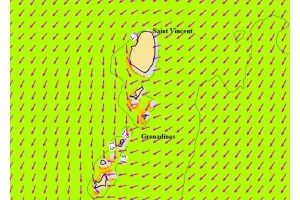Source Loop Caribbean
Beachgoers and fishermen in several Caribbean islands have been advised to exercise extreme caution as coastlines are being affected or are expected to be affected by rough waters and long-period swells. Already, some islands have issued hazardous sea alerts, small craft advisories, high surf advisories and warnings.
The St Vincent and the Grenadines Meteorological Service in an update this afternoon issued a yellow alert for SVG as northerly long period swells will continue across Saint Vincent and the Grenadines this evening into tonight, resulting in breaking waves along the coastline.
Breaking wave actions could heighten around high tide (the next high tide is at (6:17 pm).
According to the yellow alert, small craft operators and sea bathers should exercise extreme caution for breaking northerly swells. It says areas of special interest are the western and southern coasts.

In Grenada, a small craft advisory is in effect as the Meteorological Office has informed the National Disaster Management Agency (NaDMA) that it’s currently monitoring a surface trough to the west that is expected to move through the region bringing with it partly cloudy, windy, and hazy conditions with few brief isolated showers.
Reports reaching NaDMA indicate that the coastlines are already experiencing rough waters, with waves five to seven feet in open waters.
Beaches throughout the state of Grenada are very rough and can pose a danger to users. Consequently, a small craft advisory is in effect and people are advised to exercise extreme caution and avoid using the beach or venturing out at sea, particularly during high tide.
According to a bulletin from the Meteorological Office, there may be temporary reductions in horizontal visibility due to moderate to dense haze or dust, choppy seas, and moderate to rough waters. These conditions are currently affecting sea bathers, fishermen, small sailboats, and other small craft users, and are expected to last for at least 24 hours.
In Trinidad and Tobago, the Meteorological Service issued a hazardous sea alert – yellow level, stating northerly long-period swells are expected to affect the coastlines of Trinidad and Tobago. The alert goes into effect from 2 am on Sunday, February 11, and ends on February 14 at 10 am.
Meanwhile, the Antigua and Barbuda Meteorological Services says a high surf advisory is in effect for Antigua, Barbuda, Anguilla, St Kitts and Nevis until Tuesday, while a high surf advisory will go into effect tonight for Montserrat until Tuesday.
The weather synopsis says moderate long-period swells are reaching the area again and causing hazardous conditions along mainly northern and north-facing coastlines.
The Met Office says the threat level to the life, livelihood, property and infrastructure of those using the affected coastlines is expected to rise to moderate with the potential for significant impacts.
These swells could cause life-threatening surfs and rip currents on affected coastlines. A high surf advisory means that dangerous surfs of 2 to 3 metres or 6 to 10 feet will affect some coastlines in the advisory area, producing hazardous conditions.
Beachgoers, especially to the mainly affected coastlines, should be extremely cautious; bathe only where lifeguards are present or on the sheltered, less affected beaches, mainly to the south. Extreme caution is also required by those using the affected non-beach or rocky coastlines.
And a high surf warning is in effect for the British Virgin Islands until Monday while a high surf warning will go into effect for Anguilla tonight until Monday and for Barbuda tomorrow afternoon until Monday.
